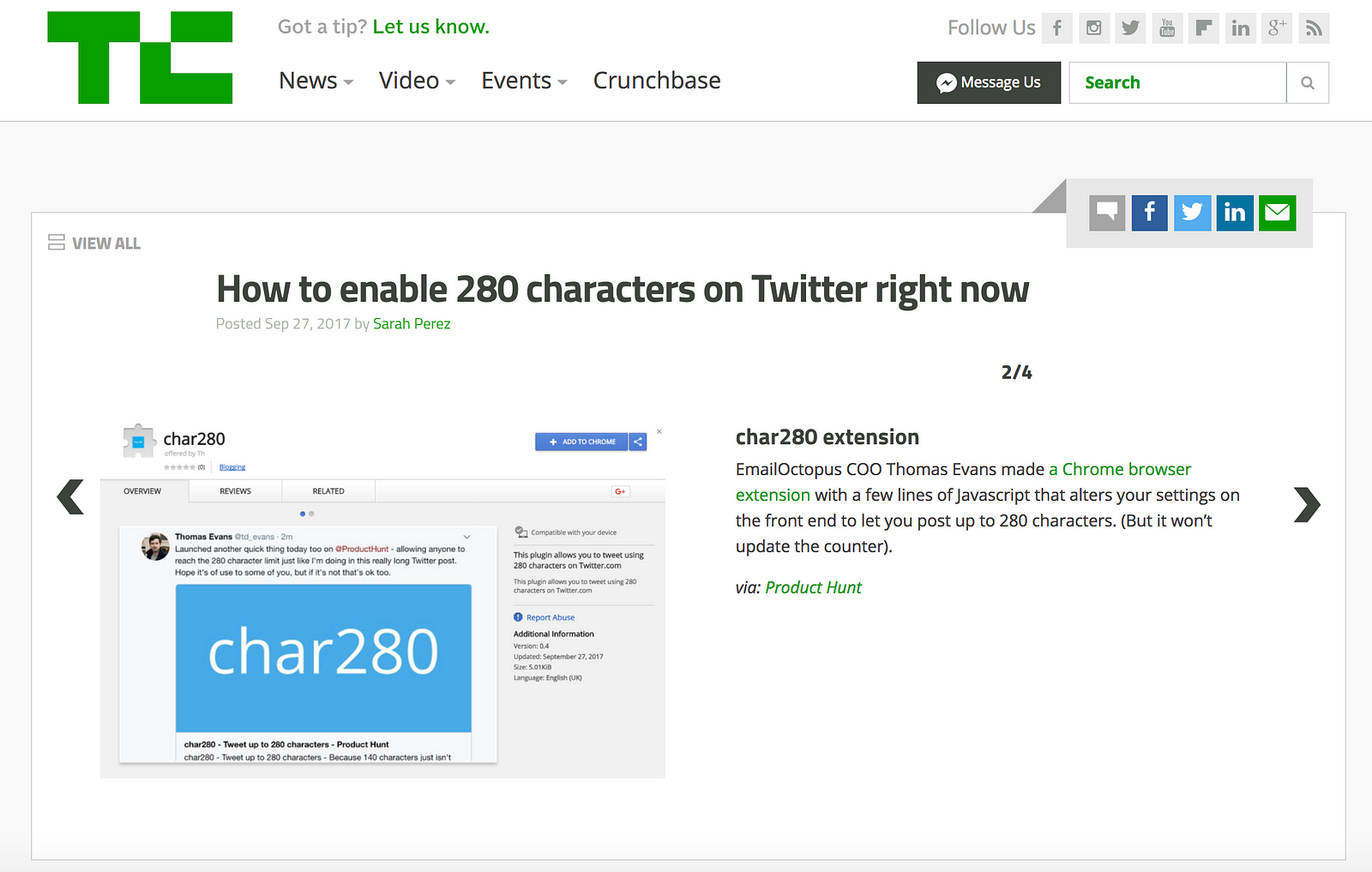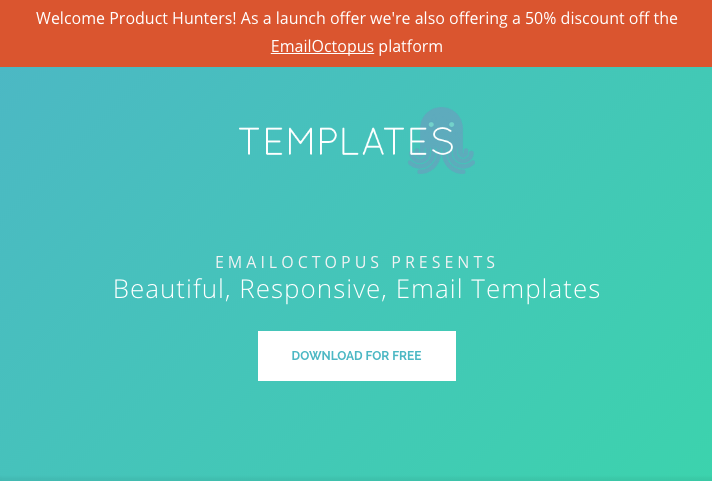At EmailOctopus, we’re incredibly passionate about side projects. After all— the platform started out as one over three years ago. The platform, conceived back in early 2014 whilst working full time on another project, is a prime example of how finding an itch to scratch or passion to fulfill can turn into something much, much larger.
Since Jonathan and I moved to work on EmailOctopus full time in 2016 we’ve launched four further side projects. Some have been as individuals, others as a team. Some have failed, some have been abandoned as we just weren’t that passionate about them, and others have gone on to be pretty successful, being used by companies such as Uber and AngelList, and having been featured on TechCrunch. Each one of them has taught us a lesson and fulfilled an urge that day-to-day work can sometimes not.
One of our most recent side projects was LookAtThatSaaS. LookAtThatSaaS was a long planned project, it was a site we'd wished existed when starting EmailOctopus, built to share resources, founders’ insights, and design inspiration for early stage SaaS businesses.

As a small team, EmailOctopus still exists today without a full-time designer, so regularly we turn to similar businesses for inspiration on how we should deal with common issues such as on-boarding or how to build an effective pricing page. We spent approximately two weeks building the site, alongside our regular BAU (business as usual) work. Many of the resources and screenshots featured on the site existed already either in our heads or on the many Trello boards we use to organise and run EmailOctopus. Building LookAtThatSaaS allowed us to not only publish a lot of that knowledge for the benefit of our team, but by making it public it has has hopefully benefited other small indie SaaS businesses just starting out who need pointers on design, onboarding best practices or pricing strategy.
In building a product for the SaaS community we brought ourselves closer to the community as a whole. Facebook groups such as SaaS Growth Hacks now regularly refer to LookAtThatSaaS and we also regularly contribute to those groups with our experiences in building an EU-based SaaS product. That relationship we’ve built with the wider SaaS community has introduced us to a number of complimentary businesses and their founders. As a result we’ve launched two brilliant integrations and launched a group discount for Black Friday called SaaSFriday, a project which brought us an additional 40 paying EmailOctopus customers.
Whilst the benefits to our core EmailOctopus brand have been beneficial, we also believe LookAtThatSaaS has potential as a standalone product. With over 5,000 visits since launch and guest post submissions from over 50 fellow founders — the project is something we’ll be persevering with as a product. It's basically an Indie Hackers combined with LandBook, designed to help new SaaS founders out and for those who have had success, to share their experience.
Other projects we’ve launched have less of a natural synergy with EmailOctopus. On the same day we launched LookAtThatSaaS, I also launched a chrome extension called Char280. Launched very much on a whim, the day after Twitter launched their 280 character limit, it had no strategy behind it nor was there a launch plan. The idea for Char280 to me early that morning, just after we’d posted LookAtThatSaaS to ProductHunt — it was that time of the morning where I usually check up on Reddit, HackerNews and the usual sources. Whilst browsing around I noticed a user had launched a script which could be run in the console, knowing the furor the change to 280 characters had caused I knew there was a potential for a quick product (as proved by the Slack message I sent that morning to Jonathan, EmailOctopus’s CEO).

Having built some Chrome Extensions previously, I was already relatively familiar with the process of making one, so in the space of around an hour the extension which enabled 280 characters for everyone and the associated landing page (built using Carrd.co) were ready and launched on Twitter, followed by Product Hunt. Almost instantly it was picked up by the team there and they began using it for their own Product Hunt Twitter feed before it featured in their newsletter the same day.
Within 1 hour of launch it was in the top position on Product Hunt (annoyingly ahead of our long planned project!). The plugin was installed around 2,200 times in 12 hours, before being blocked by Twitter (the plugin changed client side settings to enable 280 characters, but Twitter soon added server side validation).

Despite the interest and the press in launching Char280, it didn’t really impact EmailOctopus at all. But do all side projects need to do that? It was a fun project, branded, tested and shipped within hours — something that we should look to be doing regularly as a team.
Some side projects can simply be a case of opening up work which has already been done within your organisation. Last year we were struggling to find a consistent acquisition channel, which didn’t have a ridiculously high CPA, we’d tried AdWords, Facebook ads and dabbled a bit in content marketing. At that time, we were also working on adding template functionality to EmailOctopus. As we built that feature we discussed potentially open sourcing those templates, a recent launch of paid email templates on Product Hunt had attracted significant interest and upvotes, and we felt there was a big opportunity to generate leads and visibility for EmailOctopus through making those templates free to download.

We spent a few extra hours commenting the code we’d written internally, opened up the GitHub repo, built a microsite on top of Wordpress and launched the standalone product on Product Hunt. We provided the templates under the MIT License allowing anyone to use them for anything; no strings attached. Launched back in 2016 the templates have been downloaded thousands of times by marketers at Uber, PWC and AngelList.

The list of users who have downloaded the free Templates, and chosen to provide their email address.
For the extra few hours spent open sourcing the templates, we’ve managed to secure over 2,000 qualified leads without any paid marketing spend to support the project.
Side projects have been a huge help at EmailOctopus. They’ve helped employee satisfaction, they’ve sharpened some of our lesser used skills, they’ve helped build relationships with the wider community and are our second biggest traffic driver, only behind PPC.
Outside of EmailOctopus, though there are numerous examples of successful side projects spun out to generate traffic. You may not have heard of Crew, but you’ll almost have definitely used their side project, now turned full-time business, Unsplash. Launched back in 2012 with a $19 Tumblr theme and 3 hours of effort, Unsplash went on to generate 144m downloads in 2016 and is one of the most successful stock websites ever. The site, whilst a standalone success also went on to generate over 40 percent of Crew’s revenue.
At a time where we’ve all got so good at blocking ads and deleting marketing emails, side projects give you the ability to create lasting value. The process for how you come up with such ideas will be differ between each business, whether it’s through week long hackathons, a regular hackdays or just a few hours for passionate people to explore an idea that might turn into something bigger. They needn’t detract from the business as usual work, and can add so much more.
View some of our other top rated articles:

This is so encouraging. I have a big list of side project ideas that are all in the same space as our main product (productivity) and we are already putting a lot of resources behind those side projects. Excited to see what will happen!
Will report back here! :)